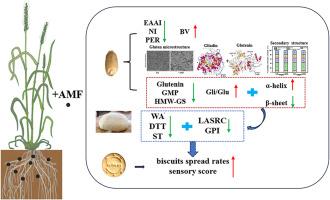Arbuscular mycorrhizal fungi affected soft wheat quality properties and nutritional index by regulating the composition and secondary structure of protein
IF 3.9
2区 农林科学
Q2 FOOD SCIENCE & TECHNOLOGY
引用次数: 0
Abstract
Arbuscular mycorrhizal fungi (AMF) inoculation has important regulatory influence on plant growth and nitrogen uptake, which are intimately associated with soft wheat yield and quality. The study aimed to investigate the impact of AMF inoculation on soft wheat grain yield, protein compositions, protein quality, secondary structure of gluten, dough properties and biscuits baking quality. In this study, AMF inoculation significantly increased grain yield. AMF inoculation decreased grain protein content by 5.1%, glutenin content by 8.5%, GMP by 14.3%, and HMW-GS by 8.8% compared with CK. Conversely, AMF inoculation increased the ratio of gliadin/glutenin. Further analysis showed AMF treatment had a looser gluten network than CK, significantly reduced β-sheet and β-turn content, while α-helix content increased. The nutritional index of grain protein was slightly reduced under AMF inoculation, yet the biological value was improved. Reduced wet gluten content, gluten performance index and dough development time under AMF treatment through regulation of soft wheat protein composition and gluten protein structure. Therefore, biscuits in AMF treatment showed reduced thickness, hardness, significantly greater spread ratio and sensory score compared with CK. These indicate that AMF application would be a beneficial agronomic practice to synergistically optimize yield and grain quality in soft wheat.

丛枝菌根真菌通过调节蛋白质的组成和二级结构影响软质小麦的品质特性和营养指标
接种丛枝菌根真菌(AMF)对植物生长和氮吸收具有重要的调节作用,而植物生长和氮吸收与软质小麦的产量和品质密切相关。本研究旨在探讨接种 AMF 对软质小麦籽粒产量、蛋白质组成、蛋白质质量、面筋次生结构、面团特性和饼干烘焙质量的影响。在这项研究中,接种 AMF 能显著提高谷物产量。与 CK 相比,接种 AMF 可使谷物蛋白质含量降低 5.1%,谷蛋白含量降低 8.5%,GMP 降低 14.3%,HMW-GS 降低 8.8%。相反,接种 AMF 会增加谷胶蛋白/谷蛋白的比例。进一步分析表明,与 CK 相比,AMF 处理的谷蛋白网络更松散,β-片和 β-匝含量显著减少,而 α-螺旋含量增加。接种 AMF 后,谷物蛋白质的营养指数略有降低,但生物价值有所提高。通过调节软质小麦蛋白质组成和面筋蛋白质结构,AMF 处理下的湿面筋含量、面筋性能指标和面团发育时间均有所降低。因此,与 CK 相比,AMF 处理的饼干厚度、硬度降低,铺展率和感官评分显著提高。这表明,施用 AMF 是一种有益的农艺措施,可协同优化软质小麦的产量和谷物品质。
本文章由计算机程序翻译,如有差异,请以英文原文为准。
求助全文
约1分钟内获得全文
求助全文
来源期刊

Journal of Cereal Science
工程技术-食品科技
CiteScore
7.80
自引率
2.60%
发文量
163
审稿时长
38 days
期刊介绍:
The Journal of Cereal Science was established in 1983 to provide an International forum for the publication of original research papers of high standing covering all aspects of cereal science related to the functional and nutritional quality of cereal grains (true cereals - members of the Poaceae family and starchy pseudocereals - members of the Amaranthaceae, Chenopodiaceae and Polygonaceae families) and their products, in relation to the cereals used. The journal also publishes concise and critical review articles appraising the status and future directions of specific areas of cereal science and short communications that present news of important advances in research. The journal aims at topicality and at providing comprehensive coverage of progress in the field.
 求助内容:
求助内容: 应助结果提醒方式:
应助结果提醒方式:


